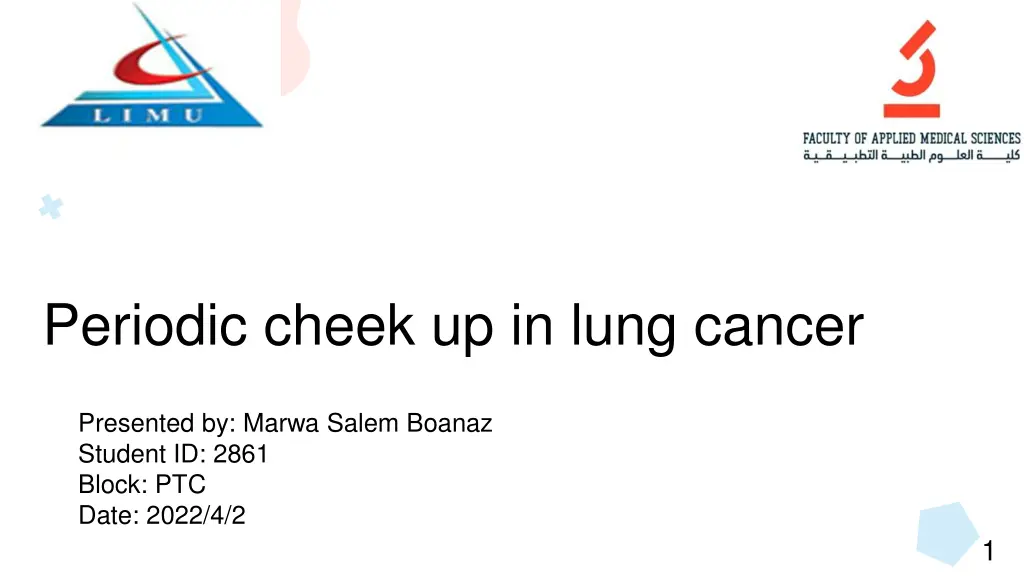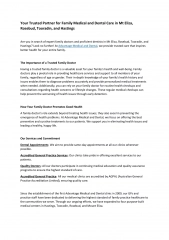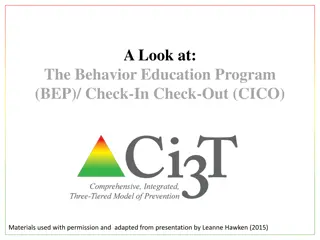
Periodic Check-Up in Lung Cancer: Early Detection Methods & Treatment
Find out how regular check-ups can aid in early detection of lung cancer through methods like CT scans, bronchoscopy, and sputum analysis. Learn about warning signs, screening techniques, treatment options, and follow-up care to combat this disease effectively.
Download Presentation

Please find below an Image/Link to download the presentation.
The content on the website is provided AS IS for your information and personal use only. It may not be sold, licensed, or shared on other websites without obtaining consent from the author. If you encounter any issues during the download, it is possible that the publisher has removed the file from their server.
You are allowed to download the files provided on this website for personal or commercial use, subject to the condition that they are used lawfully. All files are the property of their respective owners.
The content on the website is provided AS IS for your information and personal use only. It may not be sold, licensed, or shared on other websites without obtaining consent from the author.
E N D
Presentation Transcript
Periodic cheek up in lung cancer Presented by: Marwa Salem Boanaz Student ID: 2861 Block: PTC Date: 2022/4/2 1
Introduction Certain tests help finding specific types of cancers before signs or symptoms appear. Screening for lung cancer is done with attest called a low dose helical or spiral computed tomography (CT or CTA) scan, A CT scan takes picture of the inside of the body with an x-ray machine. 2
Objectives: Outline the warning signs of lung cancers. Discuss the early detection of lung cancer. Describe the methods and the treatment requirement for lung cancer according to type and stage. Discuss the follow up care after the treatment of lung cancers. 3
Warning signs of lung cancer: Dyspnea Hemoptysis Anorexia 4
Chest and shoulder pain Fever Loss of apatite 5
Early detection of lung cancers: Lung cancer screening: The most important specific methods are chest X-ray and CT Bronchoscopy: Narrow flexible tubes that goes inside of the Tracheae and airways. 6
Antibodies: Autoantibodies produced by B lymphocytes bind to self-antigens released by apoptotic or necrotic cells, forming antigen antibody (immune) complexes. ctDNA ctDNA was detectable in all late stage NSCLC cases. 8
Sputum analysis: Examination under a microscope of cells found in sputum (mucus and other matter brought up from the lungs by coughing). The test checks for abnormal cells, such as lung cancer cells. 9
American Cancer society: Age Less than 60 years Percentage 22.6% 60 to 69 years 33.3% 70 to 79 years 30.8% 80 years and over 13.3% 10
Treatment of lung cancer according to type and stage : Surgery: Surgery is part of the treatment for early-stage lung cancers, Some early stage tumors may be treated with video-assisted thoracic surgery (VATS) Radiation Therapy Radiation therapy is the use of high-energy radiation to kill cancer cells and to shrink tumors 11
Chemotherapy: chemotherapy works by interfering with the cancer cells ability to grow or reproduce. Targeted Therapy These are drugs that target specific parts of cancer cells or nearby cells that help them grow. 13
Follow-up care after Treatment: many doctors recommend follow-up visits At some point after your cancer treatment, you might find yourself seeing a new doctor who doesn t know about your medical history. It s important to keep copies of your medical records to give your new doctor the details of your diagnosis and treatment. Quitting smoking 14
Dietary supplements Diet and physical activity 15
Conclusion: The importance of periodic cheek-ups and regular follow up care can reduce the risks of getting lung cancers. 16
References: 1. Planchard D, Besse B, Groen H, Souquet P, Quoix E, Baik C et al. Dabrafenib plus trametinib in patients with previously treated BRAFV600E-mutant metastatic non-small cell lung cancer: an open-label, multicentre phase 2 trial. 2022.03:46 PM 2. Lamy A, Blanchard F, Le Pessot F, Sesbo R, Di Fiore F, Bossut J et al. Metastatic colorectal cancer KRAS genotyping in routine practice: results and pitfalls. 2022. 3. [Internet]. Ascopubs.org. 2011 [cited 3 April 2022]. Available from: https://ascopubs.org/doi/pdfdirect/10.1200/JCO.2010.33.1280 4. Nagano T, Tachihara M, Nishimura Y. Molecular Mechanisms and Targeted Therapies Including Immunotherapy for Non-Small Cell Lung Cancer [Internet]. http://www.eurekaselect.com. [cited 3 April 2022]. 5. Zhang Y, Wang Y, Su X, Wang P, Lin W. The Value of Circulating Circular RNA in Cancer Diagnosis, Monitoring, Prognosis, and Guiding Treatment. 2021. 17






















